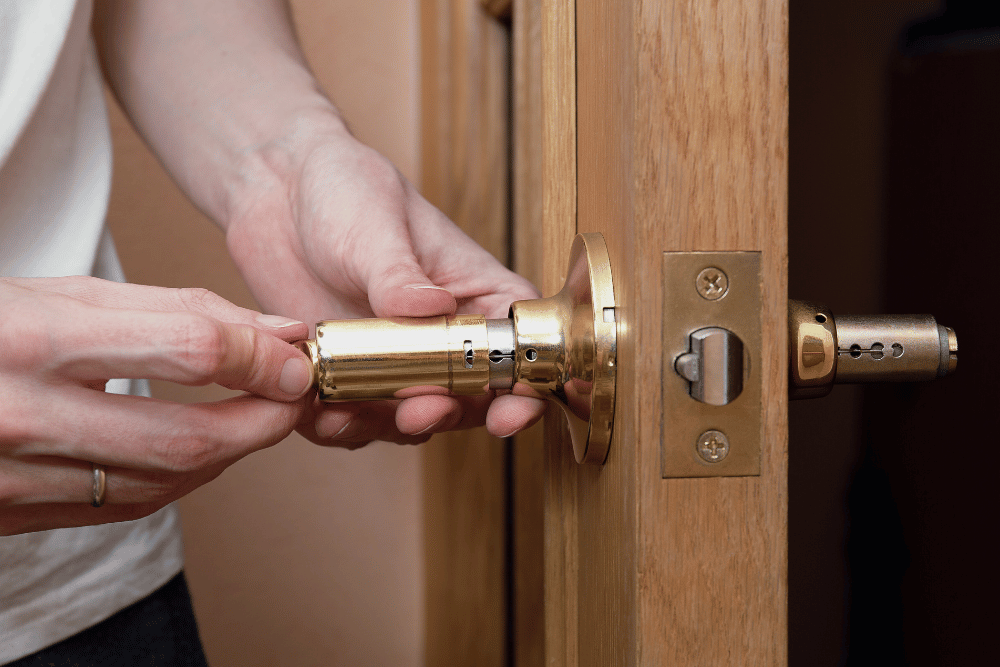How to Change Locks on Your Doors

Understanding how to change locks on doors is a fundamental aspect of securing your home. Perhaps you just moved in, or you’re looking for a simple way to make your home feel more like a fortress. No matter what your reason is for wanting to know how to change locks, this DIY guide will point you in the right direction.
The Importance of Replacing Old Locks
A common misstep in home security is underestimating the role that locks play. Homes with weak locks are significantly more likely to become the victim of burglars due to ease of access. A lock that is worn out, rusty, or visibly damaged is not only more likely to fail mechanically but can also signal potential thieves that a property is an easy mark. Changing locks on your doors to keep them in good working order is an essential preventive measure to reduce the risk of a home burglary.
Rekeying all locks should be a top priority for new homeowners immediately after moving in, even if the locks look brand new. You can never be certain how many copies of your house keys are in circulation. That’s a substantial risk when it comes to keeping yourself, your family, and your belongings safe. Even if you’ve been in your home for a while, it’s wise to change your locks every once in a while, especially if you routinely give keys to babysitters, house workers, and so on.
It should go without saying, but you should also change your locks after a break-in or similar security scare.
Additionally, newer locks often come with advanced features that provide better protection against forced entry. With a modest investment of time and money, you have high-tech protection at your front door.
Functional, updated locks are a critical component of building a layered home security system. It’s your responsibility as a homeowner to ensure that your locks are up to the task of protecting your home. Fortunately, changing locks is a relatively simple task for even novice DIY-ers.
How to Change Locks at Your House
Here are some common options available for installing a new lock and basic steps to get the job done. Because every product and brand is unique, these tips are very basic. Refer to the basic instructions that come with any kits you purchase.
Quick Set Changing
Many modern locks come with a re-keying option, which allows you to change the key that opens the lock without replacing the entire locking mechanism. To do this:
- Purchase a rekeying kit compatible with your lock brand.
- Remove the doorknob using the provided tool in the kit.
- Follow the instructions to change the pins in the lock cylinder.
- Replace the doorknob and test the new key.
Replacing Striker Plates and Screws
In many cases, builder-grade screws are short and provide minimal security. Changing locks should also include replacing striker plates and screws. For a sturdier door:
- Using a drill/screw gun with the appropriate bit, remove the existing screws from the striker plates.
- Drill a pilot hole with a 1/16-inch bit for each screw.
- Replace them with 3″ wood screws, sinking these into the door frame and studs. This offers more resistance against force.
- To keep the door stable, replace one screw on the hinges at a time with the same process. You should replace all of the screws on the side of the hinge that attaches to the door frame. However, depending on the construction of your door, you may not need or be able to replace the screws on the side attached to the door itself.
Homeowners with older homes (constructed before 1960) may need to use 2″ or 2.5″ screws to avoid damaging electrical work since construction standards have changed over time.
Installing a Deadbolt
If your door only has a handle lock, adding a deadbolt can significantly improve security.
- Purchase a deadbolt kit that fits your door thickness and backset.
- Use the template provided to mark the drilling locations on the door.
- Drill the holes for the deadbolt, following the instructions closely. To avoid splintering, it’s a good idea to drill halfway from each side.
- Install the deadbolt and test its operation with the key.
Remember to always use proper safety gear when using power tools.
Upgrading to a Smart Lock
For enhanced security and convenience, consider installing a smart lock. There are plenty of options on the market with a wide variety of features—and at a wide variety of price points.
- Choose a smart lock that’s compatible with your door and that meets your security needs. Do you want biometric identification? A keypad? Smartphone compatibility? There’s a lot out there, so prioritize what’s important to you.
- Remove the existing lock and follow the new lock’s instructions for installation. Every lock will be different, but most will fit into a standard deadbolt configuration.
- Connect the lock to your smart home system or smartphone app, enabling features like remote access and usage history.
- If possible, use a dedicated or encrypted network for the smart lock to minimize the risk of hacking.
When changing locks, always ensure that the new lock is properly aligned with the door frame to avoid any gaps or malfunctions that could compromise the door’s security or weathertight seal.
How Changing Locks Contributes to Layered Security
Securing your home by upgrading locks and doors doesn’t have to be a costly effort. By choosing these budget-friendly DIY lock options, you can significantly increase the safety of your home and provide peace of mind without breaking the bank. Remember, the key to effective home security lies in creating layers of protection. Here’s a quick overview of the layered security you should build around your home:
- Fencing
- Exterior lighting
- Landscaping
- Video surveillance cameras
- Secure doors and windows (that you keep locked!)
- Intrusion alarms
- Secure garage
- Security signage
- Regular maintenance
- Emergency planning
Prioritizing Updates When Building a Layered Security System
There are a lot of variables when considering what security updates for your home. One easy decision is investing in a live-monitored security camera system from Deep Sentinel.
Deep Sentinel’s unique offering lies in its always-ready proactive monitoring service. While DIY updates may enhance your home’s security, they usually lack the crime-stopping power of real-time response by trained professionals. Deep Sentinel’s AI-powered system immediately assesses any motion at your property, and live security guards evaluate the situation and intervene as needed. This level of active monitoring provides a higher level of security, minimizing the risk of incidents going unnoticed.
So, even if you have old, worn-out locks, a live-monitored security camera system from Deep Sentinel deters intruders before they even reach your front door.
Need a Solution that Prevents Crime?
Deep Sentinel is the only security technology that delivers the experience of a personal guard on every customer’s home and business. Call 833.983.6006 for your free security consultation.

